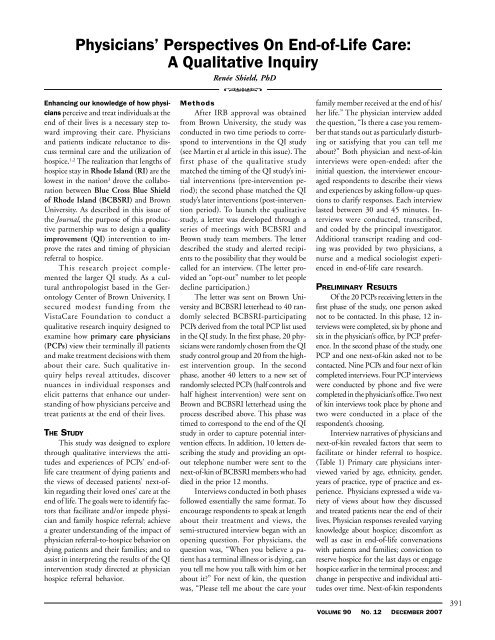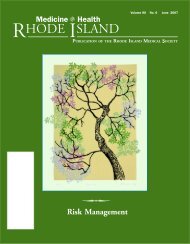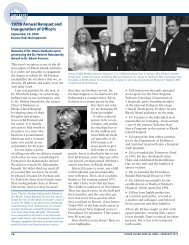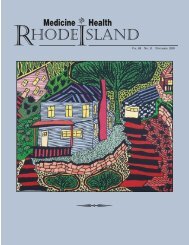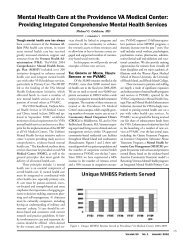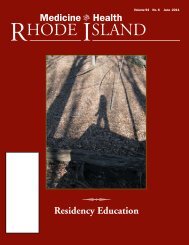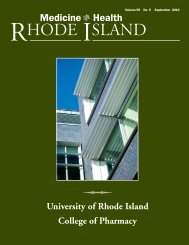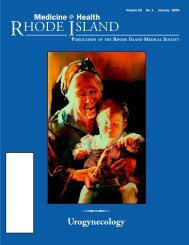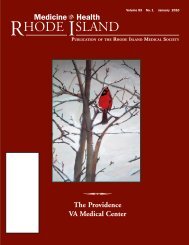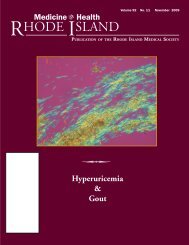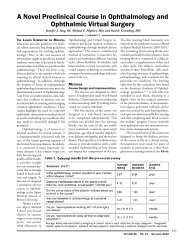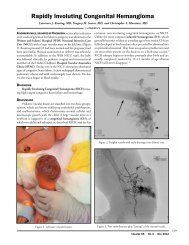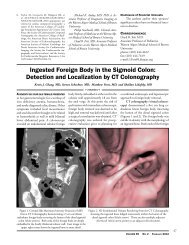The Blue Cross & Blue Shield of RI and Brown University ...
The Blue Cross & Blue Shield of RI and Brown University ...
The Blue Cross & Blue Shield of RI and Brown University ...
You also want an ePaper? Increase the reach of your titles
YUMPU automatically turns print PDFs into web optimized ePapers that Google loves.
Physicians’ Perspectives On End-<strong>of</strong>-Life Care:<br />
A Qualitative Inquiry<br />
Renée <strong>Shield</strong>, PhD<br />
Enhancing our knowledge <strong>of</strong> how physicians<br />
perceive <strong>and</strong> treat individuals at the<br />
end <strong>of</strong> their lives is a necessary step toward<br />
improving their care. Physicians<br />
<strong>and</strong> patients indicate reluctance to discuss<br />
terminal care <strong>and</strong> the utilization <strong>of</strong><br />
hospice. 1,2 <strong>The</strong> realization that lengths <strong>of</strong><br />
hospice stay in Rhode Isl<strong>and</strong> (<strong>RI</strong>) are the<br />
lowest in the nation 3 drove the collaboration<br />
between <strong>Blue</strong> <strong>Cross</strong> <strong>Blue</strong> <strong>Shield</strong><br />
<strong>of</strong> Rhode Isl<strong>and</strong> (BCBS<strong>RI</strong>) <strong>and</strong> <strong>Brown</strong><br />
<strong>University</strong>. As described in this issue <strong>of</strong><br />
the Journal, the purpose <strong>of</strong> this productive<br />
partnership was to design a quality<br />
improvement (QI) intervention to improve<br />
the rates <strong>and</strong> timing <strong>of</strong> physician<br />
referral to hospice.<br />
This research project complemented<br />
the larger QI study. As a cultural<br />
anthropologist based in the Gerontology<br />
Center <strong>of</strong> <strong>Brown</strong> <strong>University</strong>, I<br />
secured modest funding from the<br />
VistaCare Foundation to conduct a<br />
qualitative research inquiry designed to<br />
examine how primary care physicians<br />
(PCPs) view their terminally ill patients<br />
<strong>and</strong> make treatment decisions with them<br />
about their care. Such qualitative inquiry<br />
helps reveal attitudes, discover<br />
nuances in individual responses <strong>and</strong><br />
elicit patterns that enhance our underst<strong>and</strong>ing<br />
<strong>of</strong> how physicians perceive <strong>and</strong><br />
treat patients at the end <strong>of</strong> their lives.<br />
THE STUDY<br />
This study was designed to explore<br />
through qualitative interviews the attitudes<br />
<strong>and</strong> experiences <strong>of</strong> PCPs’ end-<strong>of</strong>life<br />
care treatment <strong>of</strong> dying patients <strong>and</strong><br />
the views <strong>of</strong> deceased patients’ next-<strong>of</strong>kin<br />
regarding their loved ones’ care at the<br />
end <strong>of</strong> life. <strong>The</strong> goals were to identify factors<br />
that facilitate <strong>and</strong>/or impede physician<br />
<strong>and</strong> family hospice referral; achieve<br />
a greater underst<strong>and</strong>ing <strong>of</strong> the impact <strong>of</strong><br />
physician referral-to-hospice behavior on<br />
dying patients <strong>and</strong> their families; <strong>and</strong> to<br />
assist in interpreting the results <strong>of</strong> the QI<br />
intervention study directed at physician<br />
hospice referral behavior.<br />
<br />
Methods<br />
After IRB approval was obtained<br />
from <strong>Brown</strong> <strong>University</strong>, the study was<br />
conducted in two time periods to correspond<br />
to interventions in the QI study<br />
(see Martin et al article in this issue). <strong>The</strong><br />
first phase <strong>of</strong> the qualitative study<br />
matched the timing <strong>of</strong> the QI study’s initial<br />
interventions (pre-intervention period);<br />
the second phase matched the QI<br />
study’s later interventions (post-intervention<br />
period). To launch the qualitative<br />
study, a letter was developed through a<br />
series <strong>of</strong> meetings with BCBS<strong>RI</strong> <strong>and</strong><br />
<strong>Brown</strong> study team members. <strong>The</strong> letter<br />
described the study <strong>and</strong> alerted recipients<br />
to the possibility that they would be<br />
called for an interview. (<strong>The</strong> letter provided<br />
an “opt-out” number to let people<br />
decline participation.)<br />
<strong>The</strong> letter was sent on <strong>Brown</strong> <strong>University</strong><br />
<strong>and</strong> BCBS<strong>RI</strong> letterhead to 40 r<strong>and</strong>omly<br />
selected BCBS<strong>RI</strong>-participating<br />
PCPs derived from the total PCP list used<br />
in the QI study. In the first phase, 20 physicians<br />
were r<strong>and</strong>omly chosen from the QI<br />
study control group <strong>and</strong> 20 from the highest<br />
intervention group. In the second<br />
phase, another 40 letters to a new set <strong>of</strong><br />
r<strong>and</strong>omly selected PCPs (half controls <strong>and</strong><br />
half highest intervention) were sent on<br />
<strong>Brown</strong> <strong>and</strong> BCBS<strong>RI</strong> letterhead using the<br />
process described above. This phase was<br />
timed to correspond to the end <strong>of</strong> the QI<br />
study in order to capture potential intervention<br />
effects. In addition, 10 letters describing<br />
the study <strong>and</strong> providing an optout<br />
telephone number were sent to the<br />
next-<strong>of</strong>-kin <strong>of</strong> BCBS<strong>RI</strong> members who had<br />
died in the prior 12 months.<br />
Interviews conducted in both phases<br />
followed essentially the same format. To<br />
encourage respondents to speak at length<br />
about their treatment <strong>and</strong> views, the<br />
semi-structured interview began with an<br />
opening question. For physicians, the<br />
question was, “When you believe a patient<br />
has a terminal illness or is dying, can<br />
you tell me how you talk with him or her<br />
about it?” For next <strong>of</strong> kin, the question<br />
was, “Please tell me about the care your<br />
family member received at the end <strong>of</strong> his/<br />
her life.” <strong>The</strong> physician interview added<br />
the question, “Is there a case you remember<br />
that st<strong>and</strong>s out as particularly disturbing<br />
or satisfying that you can tell me<br />
about?” Both physician <strong>and</strong> next-<strong>of</strong>-kin<br />
interviews were open-ended: after the<br />
initial question, the interviewer encouraged<br />
respondents to describe their views<br />
<strong>and</strong> experiences by asking follow-up questions<br />
to clarify responses. Each interview<br />
lasted between 30 <strong>and</strong> 45 minutes. Interviews<br />
were conducted, transcribed,<br />
<strong>and</strong> coded by the principal investigator.<br />
Additional transcript reading <strong>and</strong> coding<br />
was provided by two physicians, a<br />
nurse <strong>and</strong> a medical sociologist experienced<br />
in end-<strong>of</strong>-life care research.<br />
PRELIMINARY RESULTS<br />
Of the 20 PCPs receiving letters in the<br />
first phase <strong>of</strong> the study, one person asked<br />
not to be contacted. In this phase, 12 interviews<br />
were completed, six by phone <strong>and</strong><br />
six in the physician’s <strong>of</strong>fice, by PCP preference.<br />
In the second phase <strong>of</strong> the study, one<br />
PCP <strong>and</strong> one next-<strong>of</strong>-kin asked not to be<br />
contacted. Nine PCPs <strong>and</strong> four next <strong>of</strong> kin<br />
completed interviews. Four PCP interviews<br />
were conducted by phone <strong>and</strong> five were<br />
completed in the physician’s <strong>of</strong>fice. Two next<br />
<strong>of</strong> kin interviews took place by phone <strong>and</strong><br />
two were conducted in a place <strong>of</strong> the<br />
respondent’s choosing.<br />
Interview narratives <strong>of</strong> physicians <strong>and</strong><br />
next-<strong>of</strong>-kin revealed factors that seem to<br />
facilitate or hinder referral to hospice.<br />
(Table 1) Primary care physicians interviewed<br />
varied by age, ethnicity, gender,<br />
years <strong>of</strong> practice, type <strong>of</strong> practice <strong>and</strong> experience.<br />
Physicians expressed a wide variety<br />
<strong>of</strong> views about how they discussed<br />
<strong>and</strong> treated patients near the end <strong>of</strong> their<br />
lives. Physician responses revealed varying<br />
knowledge about hospice; discomfort as<br />
well as ease in end-<strong>of</strong>-life conversations<br />
with patients <strong>and</strong> families; conviction to<br />
reserve hospice for the last days or engage<br />
hospice earlier in the terminal process; <strong>and</strong><br />
change in perspective <strong>and</strong> individual attitudes<br />
over time. Next-<strong>of</strong>-kin respondents<br />
VOLUME 90 NO. 12 DECEMBER 2007<br />
391


